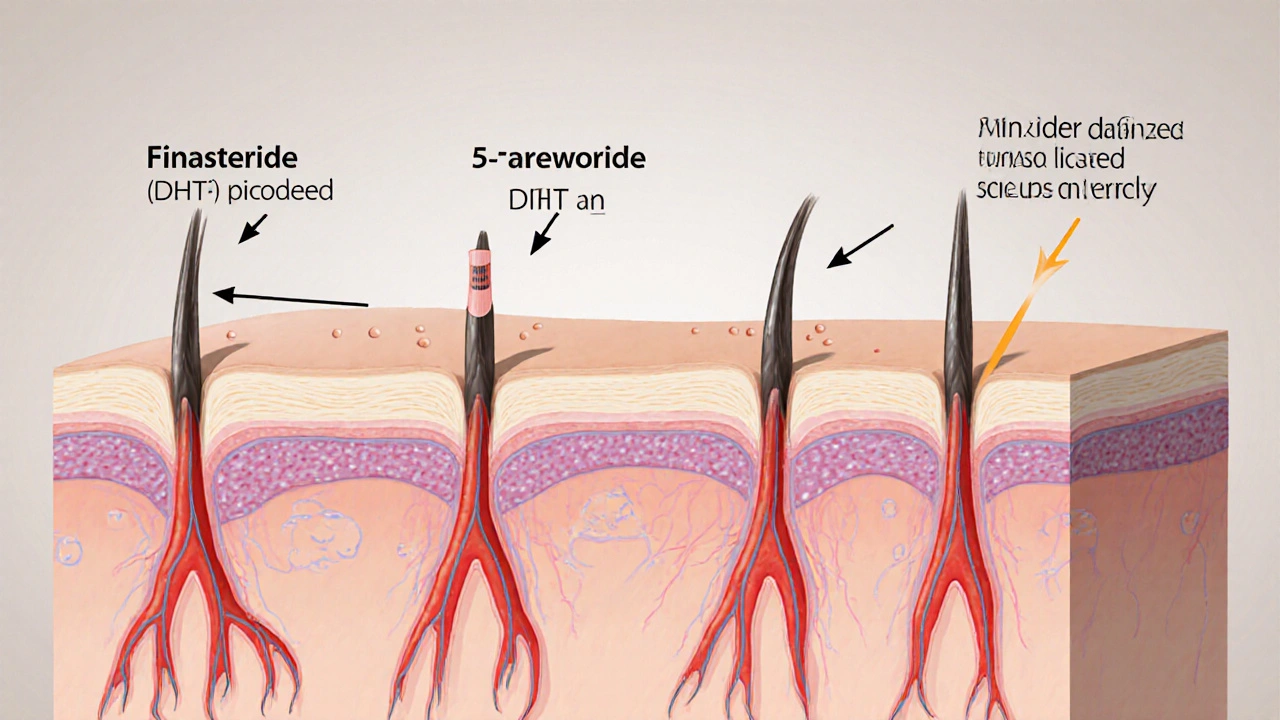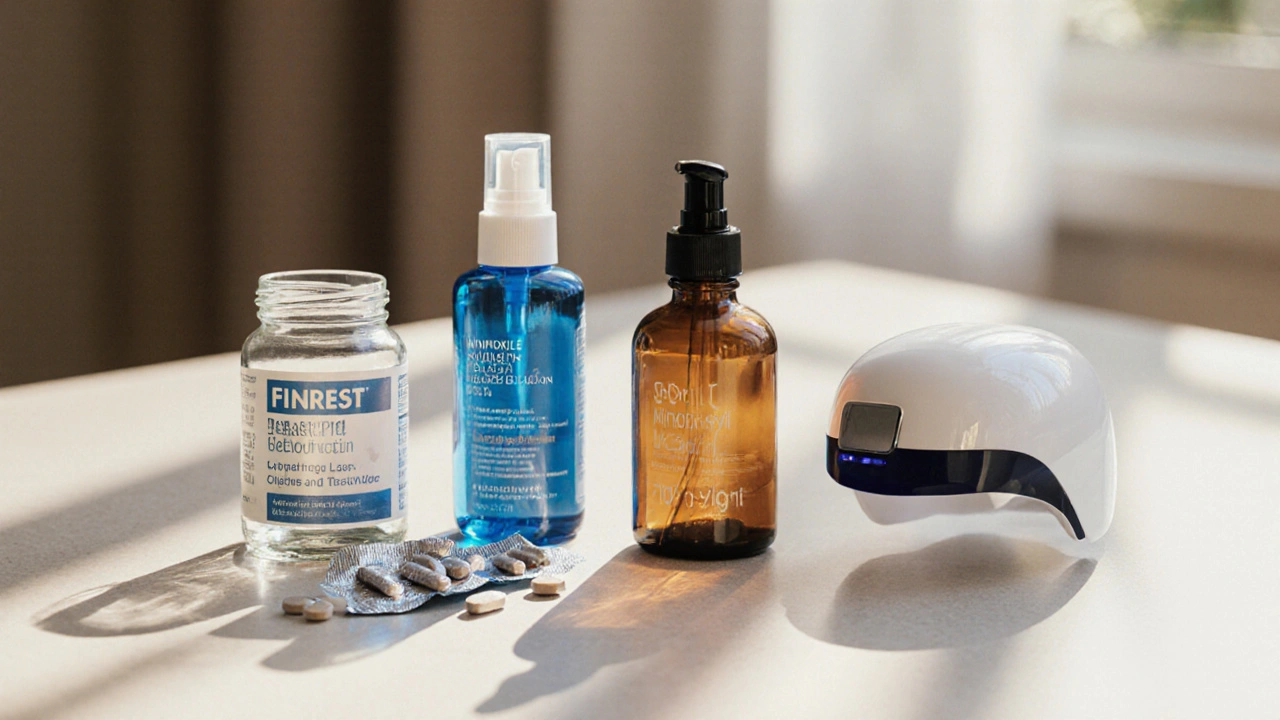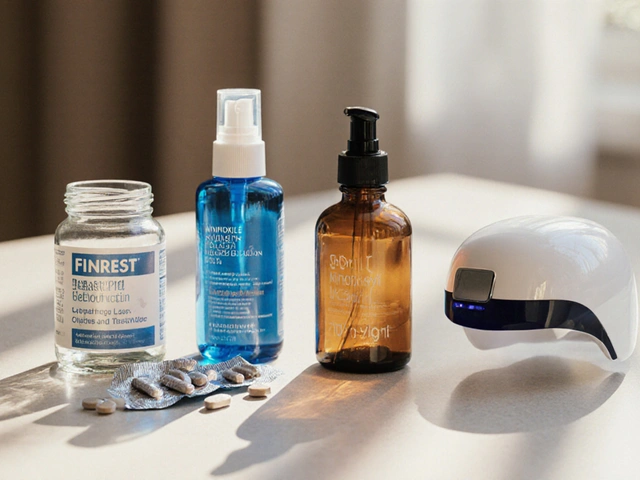Finrest vs. Hair Loss Alternatives Comparison Tool
Recommended Treatment Options
Treatment Comparison Details
| Treatment | Efficacy | Side Effects | Cost Range | Usage |
|---|---|---|---|---|
| Finrest (Finasteride 1mg) | 48-65% regrowth | 1-3% sexual side effects | $30-$60/year | Daily oral pill |
| Dutasteride 0.5mg | 55-70% regrowth | 2-4% sexual side effects | $80-$120/year | Daily oral pill |
| Minoxidil 5% Solution | 30-45% regrowth | 10-15% scalp irritation | $120-$250/year | Twice daily topical |
| LLLT (Laser Therapy) | 20-35% regrowth | None reported | $300-$1,500 (device) | 3-5x weekly sessions |
| Hair Transplant | 90-100% regrowth | Scarring, pain | $4,000-$10,000 | One-time procedure |
| Saw Palmetto | 10-20% regrowth | Mild stomach upset | $20-$40/year | Daily supplement |
Quick Summary
- Finrest (finasteride) blocks DHT production and works best for early‑stage male pattern baldness.
- Typical alternatives include dutasteride, minoxidil, low‑level laser therapy, hair‑transplant surgery, and herbal options like sawpalmetto.
- Effectiveness ranges from 30%regrowth (minoxidil) to 70%regrowth (finasteride/dutasteride) in clinical trials.
- Side‑effects are primarily sexual (decreased libido, erectile changes) for the oral inhibitors; topical minoxidil can cause scalp irritation.
- Annual cost varies widely - from under $30 for generic finasteride to $5,000+ for hair‑transplant procedures.
What is Finrest?
When it comes to treating male pattern baldness, Finrest is the branded version of finasteride, a 5‑alpha‑reductase inhibitor that reduces dihydrotestosterone (DHT) levels in the scalp. Lower DHT means fewer hair follicles shrink, which helps maintain thicker strands. Finrest is approved at a 1mg daily dose for androgenic alopecia and at 5mg for benign prostatic hyperplasia (BPH). The drug was first introduced in the mid‑1990s and quickly became the go‑to oral option for early‑stage hair loss.
Finrest is taken as a simple pill, making it appealing for men who dislike topical messes. Its popularity stems from solid clinical data: a 5‑year study showed that about 65% of users kept existing hair and 48% saw new growth.
How Finrest Works
Finrest targets the enzyme 5‑alpha‑reductase typeII, which converts testosterone into DHT. By inhibiting this enzyme, scalp DHT drops by roughly 70%, slowing follicle miniaturization. The result isn’t an immediate regrowth; you’ll generally notice a reduction in shedding after 3‑4months and visible thickening after 6‑12months.
Because the drug acts systemically, it can also affect DHT‑dependent processes elsewhere in the body, notably the prostate and libido. That’s why the 5mg formulation for BPH carries a higher side‑effect profile.
Main Alternatives to Finrest
Below are the most common alternatives that people compare against finasteride. Each has a different delivery method, mechanism, and cost structure.
- Dutasteride is a dual 5‑alpha‑reductase inhibitor (typesI&II) marketed under the name Avodart. It cuts DHT by up to 90% and is sometimes used off‑label for hair loss.
- Minoxidil is a topical vasodilator originally developed for hypertension. In 2% or 5% solutions, it stimulates follicle growth by prolonging the anagen phase.
- Low‑Level Laser Therapy (LLLT) uses red‑light devices (comb heads, caps, or helmets) to improve cellular metabolism in hair follicles.
- Hair Transplant Surgery physically relocates healthy follicles from the back of the scalp to balding areas, offering a permanent solution.
- Saw Palmetto is an herbal extract that modestly inhibits 5‑alpha‑reductase and is sold in capsules or teas.
- Finasteride 5mg for BPH is the higher‑dose version primarily prescribed for prostate enlargement, but it also reduces scalp DHT.

Side‑Effect Snapshot
| Product | Sexual side effects | Scalp irritation | Systemic risks |
|---|---|---|---|
| Finrest (1mg) | 1‑3% report decreased libido or erectile changes | Rare | Potential hormone imbalance, rare high‑grade prostate cancer alert |
| Dutasteride (0.5mg) | 2‑4% report similar issues, slightly higher than finasteride | Rare | More profound DHT suppression; monitor liver enzymes |
| Minoxidil (5%) | Negligible | 10‑15% experience itching, redness, or flaky skin | Systemic absorption can cause low blood pressure in rare cases |
| LLLT | None | None | None reported |
| SawPalmetto | Very low (≤1%) | None | Possible interaction with blood thinners |
Head‑to‑Head Comparison
| Alternative | Typical Use | Usual Dose | Hair‑Regrowth % (clinical avg.) | Common Side Effects | Approx. Annual Cost (US$) |
|---|---|---|---|---|---|
| Finrest (Finasteride 1mg) | Male pattern baldness | 1mg oral daily | 48‑65% | Reduced libido, erectile issues (1‑3%) | 30‑60 (generic) |
| Dutasteride 0.5mg | Off‑label hair loss, BPH | 0.5mg oral daily | 55‑70% | Sexual changes, rare liver enzyme rise | 80‑120 |
| Minoxidil 5% solution | Topical hair loss | 2ml twice daily | 30‑45% | Scalp itching, dryness | 120‑250 |
| Low‑Level Laser Therapy | Topical device | 15‑30min, 3‑5times/week | 20‑35% | None reported | 300‑1,500 (device purchase) |
| Hair Transplant Surgery | Permanent restoration | One‑time procedure | 90‑100% (graft survival) | Scarring, postoperative pain | 4,000‑10,000 |
| Saw Palmetto (300mg) | Herbal DHT reduction | 300mg oral daily | 10‑20% | Mild stomach upset | 20‑40 |
How to Choose the Right Option
Pick a treatment by weighing three practical criteria:
- Stage of hair loss: Early thinning (NorwoodII‑III) responds well to finasteride or dutasteride. Advanced thinning (IV‑V) may need minoxidil plus LLLT or surgical grafts.
- Tolerance for systemic medication: If you’re sensitive to sexual side effects, start with topical minoxidil or LLLT before moving to an oral inhibitor.
- Budget and commitment: Oral pills require daily adherence but cost under $100 a year. Devices or surgery demand upfront cash and occasional maintenance.
For many men, a combination works best: a daily finasteride pill to keep DHT low, plus twice‑daily minoxidil to stimulate any remaining follicles.
Managing Side Effects
Should you notice any unwanted changes, here’s a quick plan:
- Stop the medication for a week and monitor whether symptoms revert. Most sexual side effects disappear within 2‑4weeks after discontinuation.
- Discuss dosage adjustments with your doctor. Some patients tolerate a lower 0.5mg finasteride dose with minimal loss of efficacy.
- Consider switching to dutasteride if finasteride’s effect is modest, but be aware the side‑effect profile may be slightly higher.
- For scalp irritation from minoxidil, try the foam formulation or reduce frequency to once daily for a few weeks.
Never self‑prescribe hormone‑affecting drugs; a clinician can run baseline liver tests and track PSA levels if you’re also treating BPH.
Frequently Asked Questions
Can I use Finrest and Minoxidil together?
Yes. The two work via different pathways - finasteride lowers DHT systemically, while minoxidil sparks follicle activity locally. Clinical practice often combines them for synergistic results, but you should start one at a time to gauge tolerance.
Is dutasteride more effective than finasteride?
Dutasteride blocks both typeI and II 5‑alpha‑reductase enzymes, cutting scalp DHT by up to 90% versus ~70% for finasteride. Some studies show slightly higher regrowth percentages, but the trade‑off is a modest rise in sexual side‑effects. It’s an off‑label choice for hair loss and should be prescribed by a knowledgeable clinician.
How long before I see results with Finrest?
Most users report a noticeable slowdown in shedding after 3‑4months. Visible thickening typically appears after 6‑12months of consistent daily use.
Are herbal options like saw palmetto worth trying?
Saw palmetto provides a mild DHT‑lowering effect (around 10‑20% reduction). Clinical data show modest hair‑density improvements, but results are far less consistent than prescription inhibitors. It can be a low‑risk adjunct if you’re already on finasteride or want a non‑pharma option.
What is the safest option for someone with a history of prostate issues?
Finasteride 1mg is generally safe for men with BPH; it even treats prostate enlargement at the 5mg dose. However, always discuss with a urologist, have PSA levels monitored, and consider topical minoxidil if you want to avoid any systemic hormone changes.

Bottom Line
If you’re weighing finasteride against other hair‑loss methods, think of three questions: How far has your hair receded? How comfortable are you with daily pills and possible sexual side effects? How much are you willing to invest?
Finrest remains the most cost‑effective, evidence‑backed oral option for early‑stage male pattern baldness. Alternatives like dutasteride give a stronger DHT cut at a higher side‑effect risk, while topical and device‑based solutions suit those who prefer non‑systemic routes or want to combine approaches. Choose the path that matches your goals, budget, and tolerance, and keep a healthcare professional in the loop for monitoring.



Chelsea Caterer
October 4, 2025 at 13:57Finrest works but your scalp chemistry matters, mmm.
Lauren Carlton
October 14, 2025 at 09:57The article mixes efficacy percentages with cost ranges without citing primary sources; the table headings also lack proper alignment, making the data harder to compare.
Katelyn Johnson
October 24, 2025 at 05:57Great overview! It really helps to see the side‑effect profile side‑by‑side so you can weigh what matters most for your lifestyle.
Elaine Curry
November 3, 2025 at 00:57i think you could add a note that some folks experience temporary shedding when they first start finasteride – it’s a normal part of the cycle and not a reason to stop.
Patrick Fortunato
November 12, 2025 at 20:57Look, if you’re Irish‑born and proud, you might want to check if the local NHS covers finasteride; the price difference can be huge.
Manisha Deb Roy
November 22, 2025 at 16:57For anyone nervous about sexual side effects, try the 0.5 mg finasteride dose first; many patients see similar hair benefits with fewer issues.
Helen Crowe
December 2, 2025 at 12:57When you’re deciding between finasteride and its alternatives, start by mapping out three core variables: efficacy, tolerability, and long‑term cost. First, efficacy is the headline performer – finasteride’s 48‑65% regrowth beats minoxidil’s 30‑45%, but dutasteride edges a bit higher at 55‑70%. Second, tolerability matters because the 1‑3% sexual side‑effect rate, while low, can be a deal‑breaker for some men; in contrast, minoxidil’s scalp irritation affects up to 15% but is usually manageable with a foam formulation. Third, consider the financial commitment: a generic finasteride pill is under $60 per year, whereas a laser device can cost up to $1,500 upfront, and a hair transplant can run into the thousands. If you’re early in the Norwood scale (II‑III), the low‑cost oral route often yields the best ROI, especially when combined with a twice‑daily minoxidil rinse to support follicle health. For moderate loss (IV‑V), stacking finasteride with minoxidil is common practice; you’ll see additive benefits because the drugs work via separate mechanisms – one reduces DHT, the other prolongs the anagen phase. When you get to advanced stages (VI‑VII), surgical options become more attractive because you’re seeking near‑total coverage; however, many still use finasteride post‑transplant to protect existing grafts. Monitoring is key: schedule a follow‑up lab check for PSA levels if you’re on the 5 mg BPH dose, and keep a symptom diary for any libido changes. If side effects surface, a short drug holiday (one week) often clarifies whether the issue is drug‑related or coincidental. Should the side‑effects persist, discuss a dose reduction or switch to dutasteride, keeping in mind the slightly higher sexual‑side‑effect profile. Lastly, lifestyle factors like stress, diet, and sleep influence hair health; even the best pharmacologic regimen won’t fully compensate for poor habits. Bottom line: align your treatment choice with your hair‑loss stage, side‑effect tolerance, and budget, then stick with it for at least six months before judging efficacy.
Anthony Aspeitia-Orozco
December 12, 2025 at 08:57That thorough breakdown nails the practical steps – especially the reminder to log any changes; a simple spreadsheet can turn vague feelings into actionable data.
Adam Dicker
December 22, 2025 at 04:57Yo, anyone tried a DIY laser cap? I built one for $200 and the results were... meh. Saves money but the regrowth is barely noticeable.